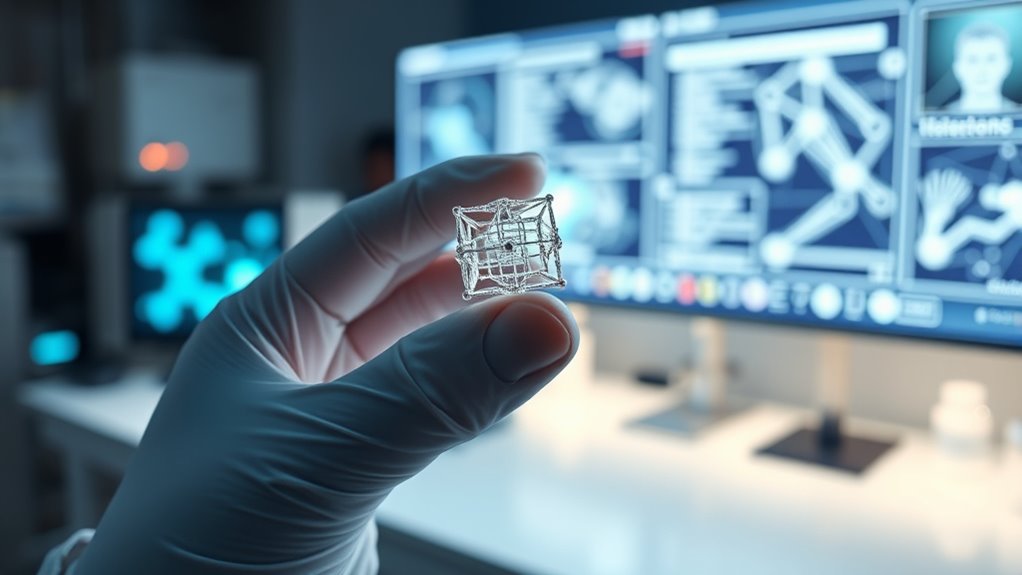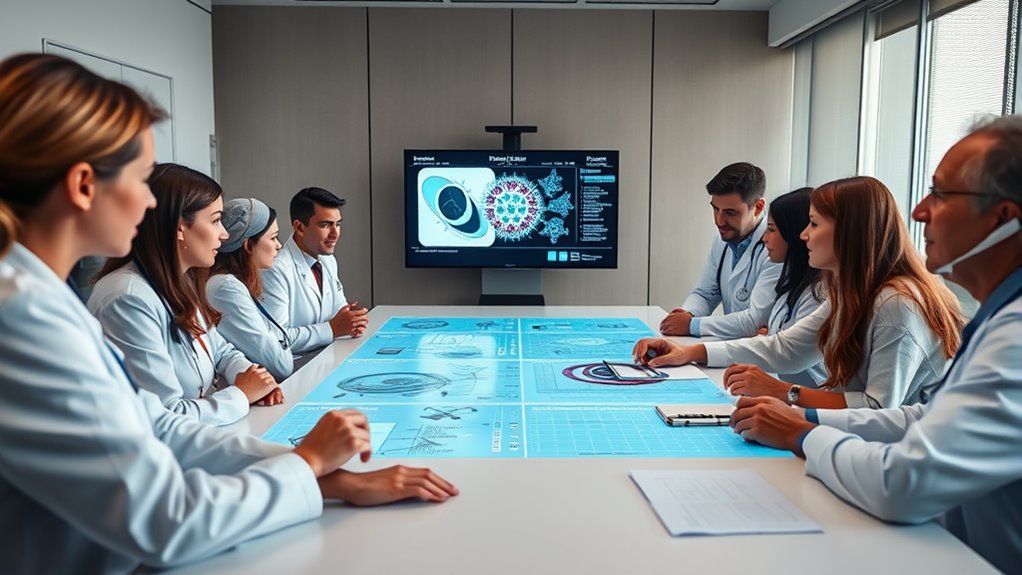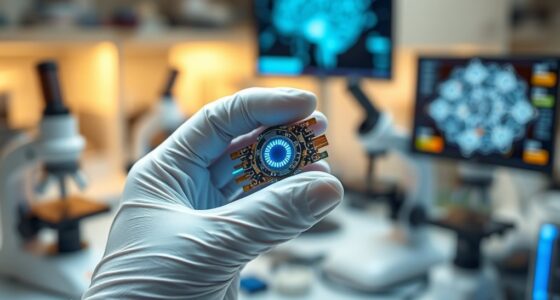When considering nanomedicine, you need to prioritize patient safety and clear communication. Since nanotech involves complex, often unpredictable materials, ensuring rigorous safety assessments is essential. You should also obtain informed consent by explaining potential risks in accessible terms, addressing uncertainties, and respecting patient choices. Transparency and ongoing dialogue build trust and support ethical practices. To understand how to navigate these challenges effectively, you’ll find valuable insights if you continue exploring this topic.
Key Takeaways
- Ensuring clear, accessible communication about nanomedicine risks supports informed patient consent.
- Addressing uncertainties and long-term safety data is vital for ethical patient decision-making.
- Tailoring information to vulnerable populations respects autonomy and enhances understanding.
- Rigorous safety assessments and transparent reporting uphold patient safety and trust.
- Engaging patients and communities in dialogue promotes ethical development and societal acceptance.
Understanding the Ethical Landscape of Nanomedicine

As nanomedicine advances, understanding its ethical landscape becomes crucial for researchers, clinicians, and policymakers alike. You need to recognize the unique challenges it presents, such as potential impacts on privacy, equity, and societal norms. Nanotechnology’s ability to manipulate matter at an atomic level raises questions about informed consent and long-term consequences that aren’t fully understood yet. You must consider how to balance innovation with responsibility, ensuring that developments benefit all segments of society without unintended harm. Engaging diverse perspectives helps shape ethical standards that guide responsible research and application. Staying informed about these issues allows you to contribute meaningfully to discussions on how nanomedicine should evolve within a framework that respects human rights and societal values. Additionally, understanding the role of projector technology in public perception can influence how ethical considerations are communicated and addressed.
Risks and Safety Concerns in Nanotechnology Applications

Nanotechnology applications in medicine offer incredible potential but also pose significant risks that must be carefully managed. You need to recognize that nanomaterials can behave unpredictably in biological systems, leading to unintended side effects. Small size and high reactivity increase the chance of toxicity, inflammation, or immune reactions. There’s also concern about the long-term environmental impact if nanoparticles are released into ecosystems. Additionally, inadequate testing can result in safety issues that harm patients or healthcare providers. To protect everyone, rigorous safety assessments and monitoring protocols are essential. You must stay informed about ongoing research and emerging risks, ensuring that nanomedicine advances do not compromise safety standards. Managing these risks is vital to harnessing nanotechnology’s full benefits responsibly. Furthermore, understanding the behavior of AI in safety monitoring can play a crucial role in developing effective oversight mechanisms for nanomedicine applications.
Informed Consent: Challenges and Strategies

Communicating complex risks in nanomedicine can be challenging, making it hard for patients to understand what they’re consenting to. You need strategies to guarantee that information is clear and that patients truly grasp the implications of their choices. Addressing vulnerable populations adds another layer of difficulty, requiring tailored approaches to protect their autonomy and understanding. For example, utilizing clear communication strategies can significantly improve patient comprehension of technical information.
Communicating Complex Risks
Explaining complex risks in nanomedicine can be particularly challenging because the technology involves intricate scientific concepts that are difficult for patients to grasp. You need to communicate potential dangers, benefits, and uncertainties clearly without overwhelming them with technical details. Simplify the language, avoid jargon, and focus on key points that impact their decision-making. Visual aids, analogies, and straightforward examples help make abstract ideas concrete. Be transparent about what is known and unknown, and encourage questions to ensure understanding. Recognizing that patients may feel anxious or confused, so your goal is to foster trust through honest, accessible conversations. Effective communication of risks is essential for genuine informed consent, especially in a field as complex as nanomedicine. Additionally, using sound healing science principles—such as leveraging frequencies and vibrations—can help create a calming environment that enhances patient understanding and comfort during discussions.
Ensuring Comprehension Effectively
Ensuring patients truly understand the risks and benefits of nanomedicine treatments is a critical challenge in obtaining informed consent. You need to communicate complex scientific concepts clearly and simply, avoiding jargon that might confuse or overwhelm. To do this effectively, consider using visual aids, analogies, or simplified summaries to make information more accessible. It’s also essential to check for understanding by asking patients to explain the information in their own words, ensuring they grasp key points. Remember, consent isn’t just about signing a form; it’s about genuine understanding. Clear communication techniques can significantly improve patient comprehension of advanced medical treatments. – Use diagrams or videos to illustrate nanomedicine concepts – Break down information into digestible chunks – Encourage questions and clarify doubts openly
Addressing Vulnerable Populations
When working with vulnerable populations, obtaining truly informed consent becomes more complex due to factors like limited health literacy, cognitive impairments, or socio-economic challenges. You need to verify that explanations are clear, simple, and tailored to their understanding. Use visual aids, plain language, and confirm comprehension through teach-back methods. Be patient and allow extra time for questions or concerns. Recognize that trust and cultural sensitivities may influence decision-making, so engage community leaders or advocates when appropriate. You should also assess capacity carefully, involving legal representatives if necessary. The goal is to respect autonomy while providing enough support to help individuals make informed choices. It is also important to consider the patient’s understanding of potential risks, especially when dealing with complex interventions like nanomedicine. By addressing these challenges proactively, you uphold ethical standards and protect vulnerable populations from potential harm.
Balancing Innovation With Patient Rights

Balancing innovation with patient rights in nanomedicine is a crucial ethical challenge that requires careful consideration. You need to guarantee that breakthroughs don’t come at the expense of patient autonomy or safety. It’s about finding a middle ground where new treatments can advance without compromising individual rights. This involves transparent decision-making, respecting patient choices, and maintaining rigorous safety standards. As you push for innovation, remember it’s essential to keep patient interests at the forefront. Embracing a creative practice mindset can foster innovative solutions that also prioritize ethical standards.
Transparency and Public Communication in Nanomedicine

You need to share clear, accurate information about nanomedicine to build public trust. Effective risk communication strategies help people understand potential benefits and dangers. Engaging the public through open dialogue encourages informed decisions and responsible development.
Clear Information Sharing
How can nanomedicine developers guarantee the public stays informed about new technologies and their implications? You need to provide clear, accessible information that everyone can understand. Transparency builds trust and helps people make informed decisions about nanomedical advances. You should use straightforward language, avoid jargon, and be honest about potential benefits and limitations. Regular updates through multiple channels ensure the public stays engaged and aware. To foster understanding, consider involving patient groups and community leaders in communication efforts. This approach makes complex topics more relatable and shows you value public input. Ultimately, open communication helps prevent misinformation and ensures everyone feels confident about the safe development and use of nanomedicine. Incorporating trusted sources and verified data can further enhance credibility and public confidence in the information shared.
Risk Communication Strategies
Effective risk communication in nanomedicine requires clear and honest messaging that helps you understand both the benefits and potential risks of new technologies. You should be provided with transparent information that explains complex concepts in accessible terms, avoiding technical jargon. By openly sharing data on safety concerns, ongoing research, and uncertainties, you build trust and enable informed decision-making. Consistent updates are vital, especially as new findings emerge or risks evolve. It’s also important that communication is timely, so you’re not left in the dark during critical moments. When transparency is prioritized, you’re better equipped to assess the implications of nanomedicine innovations and voice concerns or questions. Ultimately, honest and open risk communication fosters confidence and supports ethical development in this rapidly advancing field.
Public Engagement Efforts
Public engagement efforts play a crucial role in fostering transparency and building trust in nanomedicine. When you actively involve the public, you help demystify complex science and address concerns early on. This openness encourages informed discussions and reassures people about safety and ethical practices. Your efforts can include hosting community forums, providing accessible information, and listening to public feedback. By doing so, you create a two-way dialogue that strengthens confidence and promotes responsible development. Remember, transparency isn’t just about sharing facts; it’s about making sure everyone feels heard and understands the implications. Effective engagement ensures that ethical considerations remain a priority as nanomedicine advances, ultimately supporting societal acceptance and responsible innovation. Incorporating public communication strategies can further enhance understanding and trust among diverse audiences.
Regulatory Frameworks and Ethical Oversight

Regulatory frameworks and ethical oversight are essential for guiding the development and application of nanomedicine, ensuring that innovations benefit society without compromising safety or morality. These structures set standards for research, clinical trials, and commercialization, helping you navigate potential risks responsibly. They also foster public trust by enforcing transparency and accountability. Consider the following aspects:
| Aspect | Purpose | Example |
|---|---|---|
| Safety Regulations | Protect patients and environment | Toxicity testing protocols |
| Ethical Guidelines | Ensure moral integrity of research | Informed consent requirements |
| Oversight Bodies | Monitor compliance and enforce rules | FDA, EMA, Institutional Review Boards |
Together, these elements help you align nanomedicine development with societal values and safety standards.
Addressing Potential Long-term Effects and Unknowns

As nanomedicine advances rapidly, addressing its potential long-term effects and unknown risks becomes essential. You need to consider how these tiny technologies might behave over years or decades, possibly causing unintended harm. Long-term studies are crucial to monitor how nanomaterials interact with the body and environment. Since the science is still evolving, uncertainty remains about potential bioaccumulation or toxicity. To navigate these unknowns, you should prioritize cautious research, transparent reporting, and adaptive safety protocols. Promoting science communication about ongoing findings can help ensure that stakeholders stay informed and engaged in safety discussions.
Equity and Access to Nanomedical Treatments

Are nanomedical treatments truly accessible to all, or will they widen existing health disparities? You might worry that these advanced therapies could become available only to privileged populations, leaving vulnerable groups behind. If costs remain high, only wealthy individuals or countries could afford them, deepening inequality. Infrastructure challenges, such as limited healthcare facilities or trained personnel, could also restrict access in underserved areas. As you consider the future, it’s essential to ask how policies and funding can promote equitable distribution. Ensuring that nanomedicine benefits everyone requires proactive efforts to remove financial, geographic, and social barriers. Without deliberate action, you risk creating a healthcare landscape where innovation benefits only a select few, leaving many still without access to potentially life-saving treatments.
Fostering Ethical Research and Development Practices

Ensuring ethical research and development in nanomedicine is essential to prevent potential harms and build public trust. You play a key role in promoting responsible practices by supporting transparency, accountability, and thorough safety assessments. To foster ethical R&D, consider these steps:
- Prioritize rigorous preclinical testing to identify risks early
- Encourage collaboration between scientists, ethicists, and patients
- Implement clear guidelines that prevent conflicts of interest and guarantee informed oversight
Frequently Asked Questions
How Do Cultural Differences Influence Nanomedicine Ethical Considerations?
Cultural differences shape your views on nanomedicine ethics by influencing what you consider acceptable risks and benefits. You might prioritize community well-being, traditional healing methods, or individual autonomy differently depending on your background. These cultural perspectives affect how you perceive informed consent, trust in medical systems, and the acceptance of new technologies. Recognizing these differences helps guarantee that nanomedicine approaches respect diverse values and promote equitable, culturally sensitive care.
What Role Do Patient Advocacy Groups Play in Nanomedicine Ethics?
Patient advocacy groups passionately promote patient participation, protect patient preferences, and provide powerful platforms for public opinion. They push for transparency, push for tailored treatments, and press for policies that prioritize patient safety and informed consent. By partnering with researchers and policymakers, they guarantee ethical standards stay strong, safeguarding patient rights. Their persistent efforts help ensure nanomedicine advances align with patient needs, fostering trust, transparency, and truly patient-centered progress.
How Can Biases in Research Impact Ethical Decision-Making in Nanomedicine?
Biases in research can skew data, leading you to overestimate safety or effectiveness of nanomedicine. When these biases influence decision-making, you risk overlooking potential harms or ethical issues, which compromises patient safety. To prevent this, you should critically evaluate sources, acknowledge your own biases, and endeavor for transparent, balanced research. This approach ensures your ethical decisions prioritize patient well-being and uphold scientific integrity.
Are There Specific Ethical Concerns for Pediatric Nanomedical Treatments?
You face a monumental challenge with pediatric nanomedical treatments, as tiny innovations could dramatically impact children’s futures. Ethical concerns explode here—think about the heightened vulnerability of kids, consent complexities involving parents, and unknown long-term risks. You must guarantee safety, transparency, and informed consent, understanding that even the smallest mistake could have lifelong consequences. Steering through these issues demands utmost caution, balancing groundbreaking science with unwavering protection for your youngest patients.
How Does Intellectual Property Law Affect Access to Nanomedical Innovations?
Intellectual property law can limit your access to nanomedical innovations by granting exclusive rights to inventors and companies. This means new treatments might be expensive or unavailable in some regions, creating barriers for you. When patents are held tightly, it can slow down the distribution of groundbreaking nanomedicine, making it harder for you to benefit from these advancements. Balancing innovation with access remains a critical challenge in this field.
Conclusion
As you navigate the uncharted waters of nanomedicine, remember that ethical considerations act as your guiding star, shining a light through the fog of innovation. By prioritizing patient safety, transparent communication, and equitable access, you help build a future where technology and morality dance in harmony. Embrace these challenges with vigilance and care, ensuring that every leap forward is rooted in respect, trust, and a shared commitment to healing without harm.









